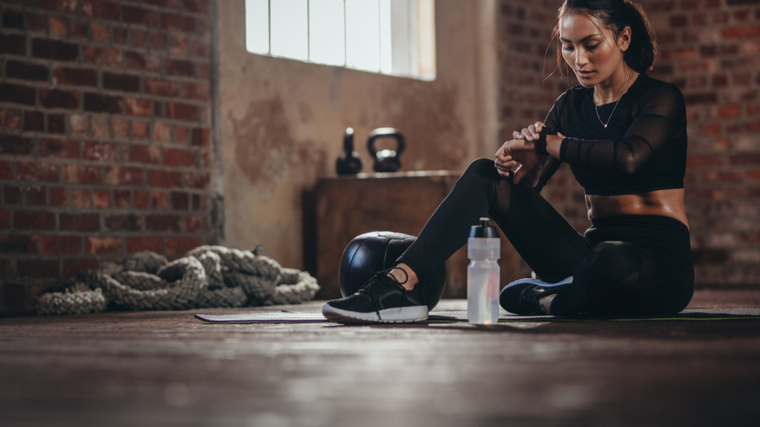If you’ve ever entered the weight room ready to squat only to find the racks were taken, you know the pain of a disrupted workout routine. If you’re strapped for time in the gym, the last thing you need is a crowd to compete with.
Bodybuilding workouts can take plenty of time to begin with, and an added time constraint can play havoc with your mood, mindset, and even the results you get from the work you put in. Sometimes, a brutal three-hour back workout just isn’t in the cards. Sometimes your training needs to be quick and dirty.

To get more out of less, you can employ some clever tricks and tactics that will keep the gains coming. Getting a good bodybuilding workout in less than an hour isn’t easy, but it’s certainly doable. Here are some tips for making your sessions more efficient and no less effective.
Time-Saving Tips for Bodybuilding Workouts
- Have a Backup Plan
- Order Your Exercises Properly
- Specify Your Warm-Up
- Focus On Compound Exercises
- Trim the Fat
- Use Supersets
- Ask to Work In
- Time Your Rest
- Sample Bodybuilding Workout
Have a Backup Plan
Indecision is the enemy of efficiency. If you walk into the gym as a blank slate, you can’t expect the universe to guide you to gains. To make the most of your time and train your muscles effectively, you should have your workout mapped out before you ever pick up a weight. However, what you put on paper doesn’t always apply in practice. There’s a chance that the workout you have planned on a given day might not be possible in the gym at the time.
Why It Works
It’s all too easy to suffer from paralysis by analysis if you don’t have structures in place to guide you. Time spent debating internally between hammer curls or dumbbell curls is time you could be training. If you know your exercises, sets, and reps ahead of time, you can move fluidly through your session without stopping to contemplate your next move.
It’s also wise to have alternatives in place. If you need to bench press, but all the stations are occupied, be ready to pivot to dumbbells instead. As long as you roughly match up your movement patterns — replacing one press with another, for instance — the implement you use once in a while won’t be a problem. You’ll still get a hearty workout in.
Order Your Exercises Properly
If you want to perform the best, your meat and potatoes movements should come first. You may find it quite difficult to deadlift at the end of a back day if you’ve spent an hour wearing yourself out with other movements. In that case, your pulling power would likely suffer. Beyond that, you can shave minutes off the clock by ordering your exercises in a way that reduces downtime, travel, and reliance on too many kinds of equipment.
Why It Works
Crossing the gym floor takes time, as does changing the equipment you’re using. You can make your workouts more convenient by grouping your lifts accordingly. On leg day, for instance, the right exercise sequence can have you running like a well-oiled machine. Here’s a sample routine showcasing how to order your movements for maximum efficiency:
- Back Squat (power or squat rack)
- Rack Pull (power or squat rack)
- Walking Lunge (dumbbells)
- Romanian Deadlift (dumbbells)
- Leg Extension (machine)
- Leg Curl (machine)
- Crunch (cables)
Specify Your Warm-Up
A good warm-up prepares you for the tasks at hand — no more, no less. If you need to make good time in the gym, there’s no reason your warm-up can’t go the extra mile. You can’t grow your muscles by walking on the treadmill, so what’s the sense in it being your entire warm-up if you’re short on time as it is?
Why It Works
Getting specific with your warm-up helps your body prepare for physical labor while also priming the relevant muscles to perform better. On chest day, this could look like a short circuit of push-ups, band pull-aparts, and bench press reps with the empty bar. A few brisk rounds will have your heart pumping just as well as the elliptical would.

Focus On Compound Exercises
Compound exercises involve more than one joint moving at a time. By association, compound lifts also involve multiple muscles or muscle groups at once. This makes them extremely valuable if you’re crunched for time. If one exercise can do the job of three others, there’s no reason to leave it by the wayside.
Why It Works
If you tried to train your back with nothing but isolation movements, you’d be stuck in the gym for hours. Isolation exercises are great for focusing on a specific area you want to improve, but take up plenty of time if you include too many.
A compound movement like the deadlift will stimulate your hamstrings, glutes, lower back, traps, forearms, and core all at once. While you may not get the same level of targeted stress on any individual area, for saving time and covering your bases, compounds are second-to-none.
The movements below are some of the best compound lifts for hitting multiple muscles at once. Your entire workout needn’t be made of big lifts like these, but every solid workout should be built around at least a few relevant compound exercises:
- Deadlift
- Front Squat
- Power Clean
- Push Press
- Barbell Row
- Pull-Up
- Dumbbell Bench Press
- Dumbbell Pullover
Trim the Fat
The flipside of working with high-value compound exercises is getting rid of redundant moves that fill your routine with bloat. Much like your physique, your training routine shouldn’t contain unnecessary fluff. There are certain movements that you may have the privilege of performing during a longer workout, such as exercises that take extensive setup, that you simply can’t squeeze in during a compressed schedule.
Why It Works
If an exercise like the pull-up trains your lats effectively, there’s no reason to weigh yourself down with two or three extra lat movements if your goal is to be expedient in the gym. The effort you spend on three exercises could be applied to just one that accomplishes the same goals. You’ll make comparable progress for far less time invested.
Use Supersets
The magic of supersets is that they allow you to get around your natural fatigue. If you tried to perform two quad exercises back-to-back, your performance on the latter would suffer tremendously. However, this isn’t as true for movements that work opposing muscles.
Why It Works
On arm day, you can pair up your biceps and triceps work and cut your rest time to almost nothing. Instead of performing a set of biceps curls and then resting for a minute or two, that “downtime” could be given to squeezing in a set of triceps extensions.
You should only feel minimal fatigue on the second half of your superset since you’re working opposing muscle groups. While your biceps rest, your triceps work. This holds true for the pecs and lats, as well as the quads and hamstrings.
Ask To Work In
The gym is a community of people with common goals. It may be intimidating to ask someone to share the equipment they’re using, but if you’re trying to go fast, it’s not a bad idea to make friends in the gym.
Why It Works
Even with a pre-planned routine, you might hit a roadblock if you waltz over to the pec deck to find it occupied. Instead of dawdling around until it frees up, you can move on to the next exercise on your list. Or, better yet, ask to work in while the person is resting. That way, your training stays on track, and you might even get a new gym buddy in the process.
Time Your Rest
If you have all day to train, you have the luxury of taking your sweet time between sets and exercises. It may seem obvious, but if you’re making efficiency a priority, you have to tightly monitor your rest periods. It’s all too easy to absentmindedly let your training run long if you’re jamming out to music or scrolling social media. Before you know it, you’ve taken five or six minutes to get back to work.
Why It Works
It’s easy to get distracted by your phone or the other goings-on in the gym and forget that you’ve spent too long resting between your sets. By setting a timer and sticking to it, you can ensure you aren’t wasting any time. For most bodybuilding exercises, resting between 45 and 90 seconds is plenty of time to get you recovered enough to go again.
As a bonus, the controlled rest times should increase your work density, providing extra challenge to your muscles — and thus extra growth.

Sample Bodybuilding Workout for Efficiency
At a certain point, you’ll undoubtedly have to spend extra time in the gym to get the results you want. But when time is short, you need to know how to condense your routine down to its bare essentials.
The arm-and-shoulder workout below showcases these principles in action — all in all, it should take less than an hour to complete. If you’re worried about getting an effective training session in with only five things on your list, don’t fret. You’ll be able to build plenty of muscle and strength with it as well, no questions asked.
The Workout
Arms and shoulders are two muscle groups particularly well-suited for time-saving techniques. Most of the exercises below involve working with dumbbells, which are easily changed out between exercises. Further, shoulder and arm exercises tend to require little to no setup, meaning you can get to work and move on in a hurry.
- Seated Dumbbell Shoulder Press superset Lateral Raise: 3×6+12
- Front Plate Raise superset Face Pull: 2×12+12
- Seated Dumbbell Curl: 3×8
- Dumbbell Overhead Triceps Extension: 3×8
- Incline Hammer Curl superset Triceps Kickback: 2×12+12
Coach’s Tip: Keep your rest times under 90 seconds. For your supersets, you’ll likely only need 30 to 60 seconds to recover fully since you’re working opposing muscles in your “downtime.”
The Big Picture
Bodybuilding is a slow burn. Any veteran competitor will tell you that their successes didn’t come overnight. From extended diets in the months leading up to a big stage appearance to workouts that separate the lambs from the lions, if you want to be great in the iron game, you’d better be prepared for the long haul.
That said, your workouts can’t always be marathons. Sometimes you have to sprint. Your training shouldn’t suffer for it, though. Luckily, with the right techniques in your pocket and some crafty creativity, you can make headway towards your goals in the blink of an eye.
Featured Image: Satyrenko/Shutterstock